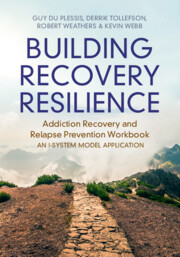 Building Recovery Resilience
Building Recovery Resilience Book contents
- Building Recovery Resilience
- Building Recovery Resilience
- Copyright page
- Contents
- Introduction
- 1 Dealing Effectively with High-Risk Situations
- 2 Coping with Cravings and Triggers
- 3 You Can’t Fix What’s Not Broken
- 4 Break the Addiction Cycle
- 5 The Requirements That Bind Us
- 6 Your Recovery Resilience Practice
- References
- Notes
- Index
1 - Dealing Effectively with High-Risk Situations
Published online by Cambridge University Press: 28 May 2024
- Building Recovery Resilience
- Building Recovery Resilience
- Copyright page
- Contents
- Introduction
- 1 Dealing Effectively with High-Risk Situations
- 2 Coping with Cravings and Triggers
- 3 You Can’t Fix What’s Not Broken
- 4 Break the Addiction Cycle
- 5 The Requirements That Bind Us
- 6 Your Recovery Resilience Practice
- References
- Notes
- Index
Summary
High-risk situations can be understood as events and situations that, if not effectively managed, pose a potential risk for relapse. What is important to note is that it is chiefly the individual’s subjective perception of “risk” that plays a significant role in whether a situation is high risk or not. A high-risk situation poses a threat to one’s perceived ability (what psychology calls “self-efficacy”) to handle the challenging situation at hand. Therefore, by developing more effective coping skills, thereby increasing perceived self-efficacy, one can learn to manage a high-risk situation without defaulting to substance use. This chapter provides practices that enables the reader to effectively deal with high-risk situations. The focus of this workbook is not to provide an exhaustive set of relapse prevention skills and tools but to help the reader to unlock their innate resilience through developing a Recovery Resilience Practice, so that they can effectively apply them.
- Type
- Chapter
- Information
- Building Recovery ResilienceAddiction Recovery and Relapse Prevention Workbook – An I-System Model Application, pp. 8 - 42Publisher: Cambridge University PressPrint publication year: 2024
